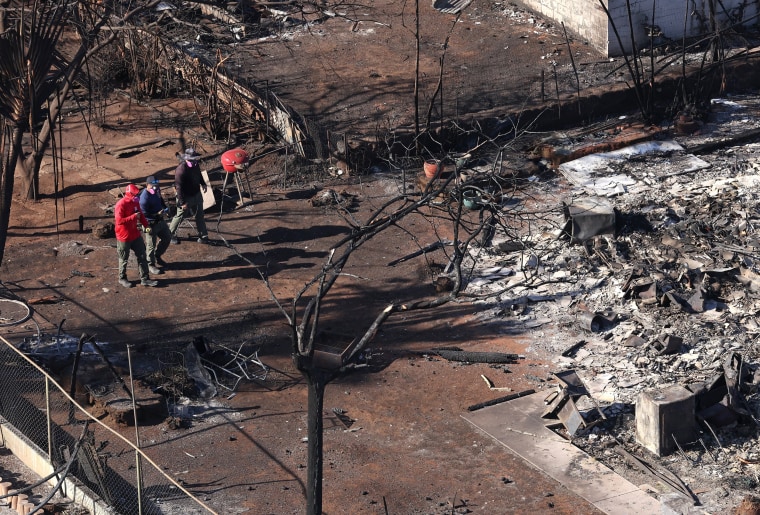“It is much like an atomic bomb hit Lahaina,” Hawaii Gov. Josh Green told “NBC Nightly News” anchor Lester Holt on Friday.
Green said the situation grew increasingly dire once telecommunications were taken out by the winds and emergency responders had their hands full with multiple conflagrations.
“It’s too early for me to tell,” Green said when asked whether the siren system wasn’t employed because of human decision or equipment failure.

“Much of the equipment was destroyed with fire and it’s a very remote place. This was a western edge of the island of Maui,” Green said. “Of course, we would never diminish any kind of responsibility. They were all fighting in fires across the islands.”
The growing frustration comes as medical workers tend to the wounded, authorities work to identify bodies, relief trickles in from the mainland, and state and local officials grapple with a massive recovery effort that will take years and billions of dollars to rebuild.
Panis, a surfing instructor, said she lost her home in the fire, which decimated Lahaina, and is now living in her car. She said that she knew some of those killed and that other residents in her community remain stranded without food or water.
“We need help,” Panis said. “The military should do better. Our government should do better. Where are all of our tax dollars really going? Where is it going? Where is the help? Where is the aid?”
Gen. Pat Ryder, the Pentagon press secretary, said Thursday that the National Guard had activated 134 members from the Army and Air National Guards to assist in Hawaii. The guard also provided two Chinook helicopters for response operations and search and rescue efforts.
Separately, the Army provided two Blackhawk helicopters and another Chinook to assist with firefighting, and the Navy sent two Seahawk helicopters to aid the U.S. Coast Guard, which had boats and helicopters already working to rescue survivors, with search and rescue operations.
Army and Navy units have completed their support efforts but will also aid the Federal Emergency Management Agency as requests come in, officials said.
The Army Corps of Engineers is also assisting with debris and getting temporary power.
Residents say help remains critical on the island, which is home to about 165,000 people and draws hundreds of thousands of tourists every month.
“They don’t have enough resources and not enough people,” said Maui resident Thomas Matthew Fevella Jr., who was handing out protein bars, snacks, water and gas for generators in Lahaina. “They need to send the military here to come and help because the Army Reserves, they’re just blocking the roads. They’re helping as well too, but we need all hands on deck.”
Claudia Garcia, president of UpCountry Strong, a Maui nonprofit organization that provides support to those facing food insecurity, said she did receive text alerts beginning at 6:30 a.m. Tuesday about brush fires, but nothing about what was occurring in Lahaina.

Her phone was also unreliable on Tuesday and Wednesday because of the spotty connection.
“I’m not here to put blame on the government, but — my honest opinion — we’re a tourist island. We have no resources and obviously our emergency risk management sucks,” Garcia said. “Like really sucks.”
“There was no designated radio station or designated TV station where you could actually go and get information,” she said. “Nothing. We have to go on Facebook.”
For others, the lack of any discernible warnings as the fires broke out deserves further examination.
“They could have turned the tsunami sirens on so people knew to evacuate,” Bryan Sizemore, a commercial sport fisherman and mechanic engineer who lives in Lahaina, said. “They’re not handling this well at all. It’s pathetic, heartbreaking really.”
Weintraub said the outdoor siren system was designed with the two main threats to the island in mind: hurricanes and tsunamis.
“A wildfire of this magnitude was unprecedented,” he said.
As with any emergency disaster, an after-action report will be opened to review every element of what was decided, Weintraub said.
“In this stage, we are still trying to feed people and still trying to shelter people,” he said. “Once we get out of that phase, we will look at those decisions that were made and if they could have been improved.”








